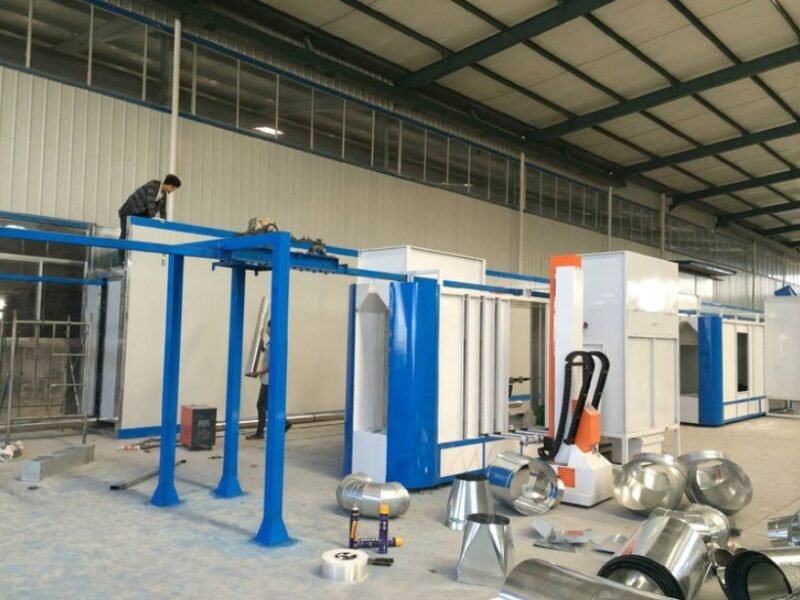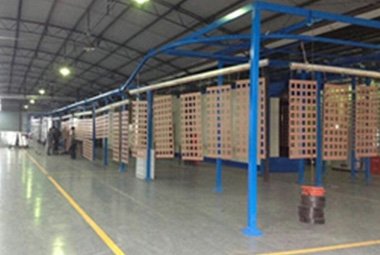
How to deal with the phenomenon of water and oil dripping on the top of the curing furnace of the powder electrostatic spraying assembly line?
Dealing with the phenomenon of **water and oil dripping** on top of the curing furnace in a **powder electrostatic spraying assembly line** is important for maintaining the efficiency, safety, and quality of the coating process. Dripping water or oil can lead to coating defects, contamination of the powder, and potentially hazardous situations, as well as reduced performance of the curing system.
Here’s a step-by-step guide on how to handle and prevent water and oil dripping on the curing furnace:
### **1. Identify the Source of the Water and Oil**
Before addressing the issue, it’s important to pinpoint where the water and oil are coming from. Possible sources include:
– **Moisture from the Air Supply System:** Humid air or moisture might be coming from the compressed air system or spray guns, which are often used for cleaning or pre-treatment.
– **Leaks from the Pre-treatment Section:** If the water comes from the pre-treatment process (e.g., washing, rinsing, or phosphating), leaks or dripping from tanks or pipes may be the cause.
– **Oil or Grease from Equipment:** Oil may be leaking from machinery parts like conveyors, motors, or fans located near the furnace, which can drip onto the top of the furnace during operation.
– **Powder Coating Process Contamination:** Excessive powder spray or debris might mix with moisture, creating sticky residues that cause oil and water to drip onto the furnace.
—
### **2. Improve the Air Handling and Filtration System**
To prevent moisture buildup from the air supply, ensure that:
– **Compressed Air Dryers:** Use air dryers to remove moisture from compressed air before it reaches the spray system. This prevents water droplets from forming and contaminating the powder or curing furnace.
– **Proper Ventilation:** Ensure proper ventilation around the furnace area to prevent excessive moisture buildup and ensure air circulation. This includes checking exhaust systems to remove humidity and other airborne contaminants.
– **Dehumidification:** If the humidity level in the facility is high, consider installing dehumidifiers near the curing oven or throughout the spray booth area to reduce moisture levels in the air.
—
### **3. Check and Maintain the Pre-treatment Area**
If the issue arises from the pre-treatment process, implement the following measures:
– **Inspect and Repair Leaks:** Regularly check the water supply pipes, tanks, and spray systems for leaks or blockages that may cause water to drip or accumulate on the furnace.
– **Use Proper Drainage Systems:** Install efficient drainage systems under the pre-treatment equipment to channel any excess water away from sensitive areas like the curing furnace.
– **Drying the Parts:** Ensure that parts entering the curing oven are fully dried after washing or rinsing in the pre-treatment process. Use drying booths or air knives to remove excess water from the parts before they enter the furnace.
– **Maintain Temperature Control:** The curing oven should be set to a proper temperature to prevent condensation of moisture inside the oven, which can contribute to water buildup.
—
### **4. Prevent Oil Leaks from Equipment**
To avoid oil or grease dripping from machinery:
– **Regular Maintenance of Equipment:** Ensure that all moving parts, conveyors, and machinery near the furnace are regularly inspected and maintained. Lubricate components properly to avoid excessive oil leaks.
– **Install Oil Containment Trays:** Install containment trays or drip pans under motors, bearings, and other oil-lubricated machinery to catch any leaks before they reach the curing furnace.
– **Check for Faulty Seals:** Inspect seals and gaskets on equipment near the curing furnace for wear and tear. Replace seals regularly to prevent oil leakage.
– **Use Non-oily Lubricants:** Where possible, switch to non-oily or dry lubricants for components near the curing area to minimize the risk of contamination.
—
### **5. Clean and Maintain the Curing Furnace**
Water or oil buildup on the top of the curing furnace can cause performance issues or contamination. To keep the furnace clean:
– **Regular Cleaning:** Routinely clean the exterior and interior of the curing furnace to remove any water, oil, or powder buildup. This will prevent the contaminants from interfering with the curing process or affecting the coating quality.
– **Check for Residue Buildup:** Inspect the furnace top for any oil or water residue. If left unchecked, it can create sticky or dirty spots that attract powder overspray, leading to a poor finish.
– **Surface Treatment:** Consider applying heat-resistant coatings to the furnace’s exterior to reduce the risk of buildup of any oil or water, and make cleaning easier.
—
### **6. Ensure Proper Curing Conditions**
– **Temperature Control:** Proper temperature management within the curing furnace is critical. If the furnace is too cold or there are temperature fluctuations, it may cause condensation, leading to water drips. Ensure that the furnace is operating within the optimal temperature range for curing (typically 150–200°C depending on the powder type).
– **Humidity Control:** In addition to dehumidification in the workspace, make sure the curing oven’s internal environment is free of moisture. A well-calibrated temperature control system will help prevent condensation inside the oven.
– **Proper Loading of the Oven:** Avoid overloading the curing oven, as this may lead to uneven heating and contribute to condensation buildup.
—
### **7. Monitor and Adjust Operational Procedures**
– **Check Spray Gun Setup:** Ensure that the electrostatic spray guns are properly adjusted to minimize overspray and moisture buildup. Over-spraying or improper application can lead to powder contamination that causes excess moisture.
– **Maintenance Log:** Keep a detailed maintenance log to track any recurring issues with water or oil leakage and take proactive measures for repairs or adjustments.
—
### **8. Implement a Preventative Maintenance Program**
Set up a **preventative maintenance program** that includes:
– **Regular Inspections:** Inspect the spray booths, curing furnace, and associated equipment on a scheduled basis to identify potential issues before they become serious.
– **Troubleshooting Protocols:** Have a standard operating procedure (SOP) in place to quickly identify and resolve issues like leaks, excess moisture, or oil buildup.
– **Training Staff:** Train operators and maintenance staff to identify early signs of potential issues (e.g., unusual dripping, noise, or powder buildup) so that they can take corrective actions immediately.
—
### **Conclusion**
Water and oil dripping on top of the curing furnace in a powder electrostatic spraying assembly line can lead to coating defects, contamination, and reduced efficiency. Addressing the issue requires identifying the source of the water and oil, improving equipment maintenance, controlling environmental conditions, and implementing effective cleaning and preventative measures. By regularly monitoring and maintaining the system, you can avoid these problems and ensure a smooth and high-quality coating process.
electrostatic magic powder
electrostatic magic powder coating peterborough
electrostatic magic powder coating review
electrostatic magic powder coating system
electrostatic manual powder coating system cl 668 l3
electrostatic paint powder coating
electrostatic paint sprayer vs powder coating
electrostatic paint vs powder coat
electrostatic painting and powder coating
electrostatic painting and powder coating las vegas nv
electrostatic painting powder coating

